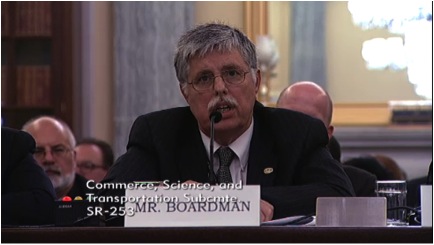“Last year we spent more than $40 billion on highways, and Lord knows we need that -- but that’s more than we spent on Amtrak in its entire 40-year history,” New Jersey Senator Frank Lautenberg said this morning at the start of a hearing on the future of passenger rail. “And unfortunately, some say we can't afford vital public investments like these right now. And I say we can’t afford not to make these investments.”

“It’s not enough just to say we’re going to cut service,” Lautenberg went on. “It’s like cutting throats.”
The longtime rail champion took the opportunity to slam the House Republican plan to privatize the Northeast Corridor, and Amtrak CEO Joseph Boardman agreed that it would be disastrous. Boardman said privatization ran a huge risk of compromising safety and the environment.
More significantly, the Republican proposal is based on the assertion that Amtrak doesn’t do a good enough job of managing its own assets, and that a private company would be better suited to do so. But an audit of Amtrak shows great progress, testified Amtrak’s inspector general, Ted Alves.
“Ridership and revenue have grown steadily, and this year the company expect to exceed 30 million passengers for the first time,” Alves said. “Amtrak is also focused on improving management practices and financial performance and is finalizing a new strategic plan.”
Alves had several ideas for savings and improvement, but none of them had to do with privatizing its core asset. For example, he suggested restructuring Amtrak’s debt, which the company is working on, in conjunction with the Departments of Transporation and Treasury. Amtrak has identified 39 other leases that could be restructured to save money, but its authorization to do so has expired.
Alves also suggested improving long-distance train service, but said the key factor is reliability, and that can’t change unless the host railroads stop prioritizing freight trains over passenger rail and improve infrastructure, which they say they won’t do without more federal subsidies.
Indeed, many keys to Amtrak’s success are out of the company’s hands, as was confirmed by Mitch Behm, inspector general for rail at USDOT, who made it clear that the Federal Railroad Administration had not yet implemented all the legal provisions aimed at making the agency a more effective overseer of Amtrak. Specifically, he criticized the lack of a National Rail Plan.
Meanwhile, witnesses and senators alike criticized House plans to remove funding from “state-supported” short routes, which make up almost half of all Amtrak ridership. He said federal policy didn’t tell Amtrak to go out to the states and dictate what they would pay, but to negotiate with them based on their ability to pay. “How much more of the costs to the country, to Amtrak, do the states need to pick up?” he asked. He acknowledged that states needed to increase their contribution, but said it wasn’t going to be possible to drain “every nickel” out of the states. And Boardman went on to slam House Republicans for proposing to precipitously cut off support to the state routes:
But in their wisdom, there was a decision made that oh, by October 1, if we were to pass this, we would cut off the states entirely, without any compassion and understanding for the people who needed to get to work, or to a doctor’s office. Forty-three percent of our long distance ridership, so a significant portion of the state ridership, is the disabled population. It’s a lot easier for tem to use our trains than it is to use any other mode of transportation. And there is no other mode on the surface of the United States that connects the country together, than rail. None.
New Mexico Sen. Tom Udall wanted to know why the fast-growing intermountain West wasn’t slated for high-speed rail improvements, and Boardman emphasized that in order to get high-speed rail, the first step is just to maintain the presence of any rail service at all. And that means not letting Congress strip away existing state routes.
Boardman also put in a plug for the Gateway tunnel, the proposed replacement for the ARC tunnel under the Hudson River, which New Jersey Gov. Chris Christie nixed last year. “If we’re not going to move forward with that, we’re going to run out of capacity on Northeast Corridor relatively soon. Within less than 20 years, there will be no additional capacity. So for all those that believe that they can add more trains, either south or north of New York, they’ll not be able to, because it’ll be dictated by the bottleneck of the tunnels and the service areas in Penn Station.”
As for high-speed rail – forget about it, he said, unless they can double capacity in the tunnels. And since the Northeast Corridor helps subsidize money-losing routes around the country, failing to move forward with the Gateway Tunnel would be another blow to corridors, in New Mexico and elsewhere, that want to see service expanded, not diminished.





